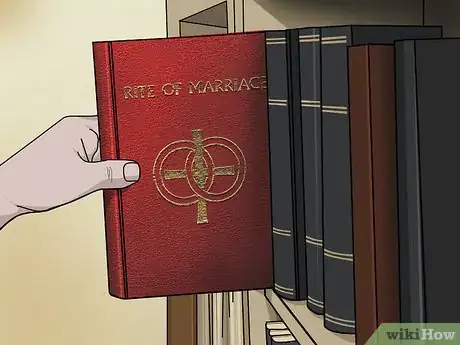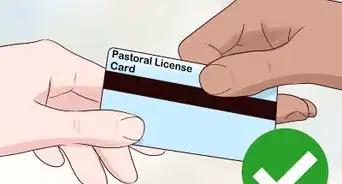This article was co-authored by wikiHow Staff. Our trained team of editors and researchers validate articles for accuracy and comprehensiveness. wikiHow's Content Management Team carefully monitors the work from our editorial staff to ensure that each article is backed by trusted research and meets our high quality standards.
There are 13 references cited in this article, which can be found at the bottom of the page.
wikiHow marks an article as reader-approved once it receives enough positive feedback. In this case, 82% of readers who voted found the article helpful, earning it our reader-approved status.
This article has been viewed 246,282 times.
Learn more...
For Catholics, marriage is more than a civil contract between a man and a woman. It is a sacramental commitment between you and the church, much like a baptism. The marrying priest's archdiocese dictates the requirements of how to be married in a Catholic church. The process can take 6 months to a year and it comes with some general guidelines. If you tell your priest the happy news, secure the correct documents and take required pre-marriage courses, you will be walking down the Catholic aisle before you know it.
Steps
Making Initial Contact
-
1Get involved at your home church. The Catholic church prefers a wedding be celebrated at one of the engaged person's own church. Your local priest or deacon will have to give the initial green light for your readiness for marriage; so you will want to make a good impression.[1]
- If you don’t live near the church you were baptized or confirmed in, start attending regular mass and sign up to be a member at a Catholic church you’d like to be married in.
- Get approval from the pastor of the church you want to get married in, if it's different from your local church.
- If you plan on being married in a region different from your local church, find which diocese that region is a part of.
- The United States Conference of Catholic Bishops has a zip code search tool to find your diocese.[2]
-
2Make an appointment for marriage preparation. Getting married in a Catholic church takes time and it requires the right assessments and paperwork. After you decide to be married, contact the right people at your home church ASAP. At some parishes this is the priest, and at others this can be a designated layperson. During this initial appointment, you will go over the rules and procedures for your diocese.
- Each party must be able to give full consent to marriage.
- Each engaged person should not show signs of coercion.[3]
- Mental illness can prevent full consent.
- The sacrament of marriage will be explained and should be understood.
Advertisement -
3Gather the correct documents. You will have to show your priest a copy of your baptismal certificate that is less than six months old. Call the church you were baptized in to find out how to do this. You will need to give them your full name, date of birth and the names of your parents. Only one spouse has to be Catholic to be married in a Catholic church. However, your fiance should be a baptized Christian. If one of you is not baptized, you can still be married in a Catholic church, but it won't be sacramental.[4]
- If you are widowed, you will need to show evidence of death paperwork.
- If you received an annulment of a previous marriage, you will need to show your priest this paperwork.
- You can apply for a Declaration of Nullity, if you do not have an annulment from a previous marriage. This will be decided by a tribunal at your home parish.
Preparing for Marriage
-
1Take a pre-marriage inventory. This is an assessment given by your priest that helps determine the strengths and weaknesses of your relationship. FOCCUS is a popular test, but each parish picks which inventory they use. It will give the priest an indication of the right counseling program for you and your spouse, because it will test in areas like communication, finances, interfaith marriages and sexuality.[5]
-
2File the right paperwork. If you are a confirmed Catholic, but marrying a baptized person from another Christian religion, you will have to file a dispensation form. Other dispensation forms are for when a Catholic is marrying a non-baptized person.[6]
- You will have to get a “Permission to Enter into a Mixed Marriage Form” from your priest, if you’re marrying a baptized non-Catholic.
- If you’re marrying someone not baptized, like an Atheist, Muslim or Jewish person, you will need your priest to approve a “Dispensation From Disparity of Cult Form.”
- A wedding between a Catholic and someone not baptized can still be held in a Catholic church, but it won't be considered a sacrament until both parties are baptized.
-
3Test your faith readiness for a Catholic marriage. You and your spouse will be tested in front of your priest. He will base the individual assessment on written or verbal responses from both of you. Since marriage in the Catholic church is a sacrament, the priest must determine you have presence of faith in order to marry you.
-
4Meet with your priest to reserve a wedding date and time. Remember that many churches do not hold weddings on Sundays, since it conflicts with regular mass. Many do not hold wedding ceremonies during Lent either, since it is a time for penance and not celebration. Consult your priest before you set a definite date in order to prevent conflicts.
Going to the Altar
-
1Start your marriage preparation program. The Catholic Church requires couples go through preparation classes to confirm their commitment to each other and the church. Programs vary from parish to parish and different dioceses, but many include group interaction with other engaged couples. Some courses are weekend getaways, while some are held on scheduled evenings.[7]
- Specific programs are offered for things like remarriage, bringing children into a marriage and interfaith marriages.
- Some of the issues covered are prayer, the meaning of marriage and sacramental roles.
- Most classes are taught by an experienced married couple.
- You will receive a certificate of completion to present to the marrying priest upon finishing the course.
-
2Apply for financial help, if you need it. The Catholic church stresses that financial issues should never be a hindrance, when a couple is ready for marriage. Wedding offerings are determined by each parish and can cover things like an organist or vocalist. Marriage preparation classes often include only material costs.
- If you and your future spouse are experiencing financial hardship, you can come to an agreement with your local priest.
- Ornate clothes and fresh flowers are considered extras by the Catholic Church and are not things they help with.
-
3Take a Natural Family Planning (NFP) class.[8] This is a requirement for marriage in a Catholic Church and early registration is recommended by most dioceses. They like couples to learn the method several months before marriage. The class will go over biology and how to use ovulation cycles to plan for children.[9]
-
4Decide on prayers and music. The Catholic church has different handbooks you can choose prayers and music from. "Together for Life" and the "Rite of Marriage" have bible verses and music appropriate for a Catholic wedding.[10]
- You can make a couple of different choices on how you respond to the priest during the ceremony.
- You can choose from several different prayers the priest will use throughout the ceremony.
- Music must be similar to what you hear during regular mass.[11]
-
5Go to confession before your wedding. Some parishes require the sacrament of reconciliation before marriage, if both parties are Catholic. Others may not require confession, but they still strongly recommend it.[12]
Rosary Prayer
Community Q&A
-
QuestionIf I'm Catholic but my fiancee is Protestant, can we get married in the Catholic church?
 Community AnswerYes, but you may need to get a dispensation.
Community AnswerYes, but you may need to get a dispensation. -
QuestionI have received the Catholic Sacraments of baptism, reconciliation, and communion, but not confirmation; my fiance has been confirmed by the Catholic Church. Are we still eligible to be married in a Catholic church?
 Community AnswerYes. My fiance is not Catholic at all, but we are still getting married in a couple weeks in a Catholic church with a full mass.
Community AnswerYes. My fiance is not Catholic at all, but we are still getting married in a couple weeks in a Catholic church with a full mass. -
QuestionCan I still marry in my hometown Catholic church if I haven't been a member due to a lot of travel for my job?
 Community AnswerYes, that shouldn't be a problem. Just make sure you notify the priest first.
Community AnswerYes, that shouldn't be a problem. Just make sure you notify the priest first.
Warnings
- Don't forget to go to City Hall or Town hall to get your marriage license in the state you're marrying in!⧼thumbs_response⧽
References
- ↑ http://www.foryourmarriage.org/saying-i-do-what-happens-at-a-catholic-wedding/
- ↑ http://www.usccb.org/about/bishops-and-dioceses/diocesan-locator.cfm
- ↑ http://togetherforlifeonline.com/getting-married-in-the-catholic-church/
- ↑ https://www.catholic.com/qa/do-i-need-to-be-confirmed-to-be-married-in-the-church
- ↑ http://www.catholicmarriageprep.com/course-info/premarital-inventory
- ↑ http://www.foryourmarriage.org/catholic-marriage/faqs/
- ↑ http://www.catholicmarriageprep.com/resources/steps-to-the-altar
- ↑ http://archden.org/eflm/nfp/
- ↑ https://www.familyministries.org/resources/index.asp?c_id=56&
About This Article
To get married in a Catholic church, at least one of you has to be a confirmed Catholic. If you want the marriage to be sacramental, you also both need to be baptized. In this case, you’ll need to file a dispensation form, which you can get from your priest. You’ll need to be a regular member at the church you want to get married in and get approval from your priest. They will likely set up a meeting with you to find out about your relationship and make sure you’ll be a suitable husband and wife. For more tips, including how to choose prayers and music for your church wedding, read on!












































































